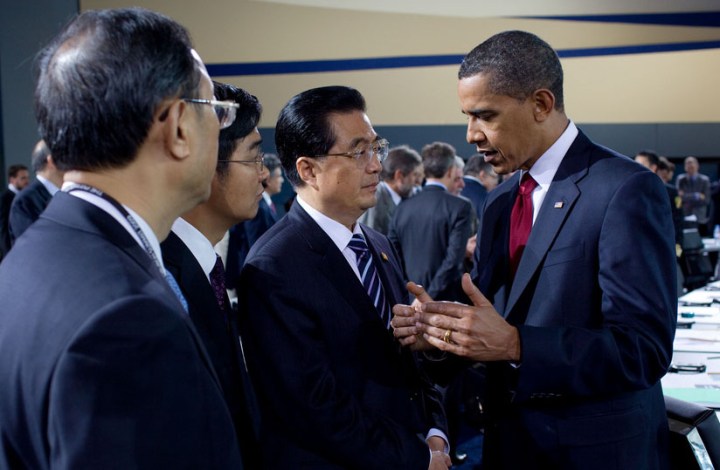Business Maverick, Politics
Analysis: China gets serious about climate change. Not a moment too soon.

Chinese President Hu Jintao put his stamp on the one-day UN climate change summit held on September 22 in New York, promising to cut carbon dioxide emissions per unit of GDP by "a notable margin" by 2020 from the 2005 level. The notable margin is still a quantitatively obscure concept, but at least it envisions driving the primary engine of world economic growth away from coal and oil towards a mixed-energy policy. By Mark Allix
It is also some sort of public commitment to act, which is far removed from China’s usual stance on its economy, where statistics are often treated as state secrets. One Chinese official in New York said this was the first time a Chinese leader has revealed the country’s target at an international conference – whether Hu really revealed anything or not.
China has good reason to take climate change seriously. It has a population of about 1.3 billion that makes up some 20% of the world total, and GDP growth that has averaged between 8% and 12% over the past two decades. While the country’s 2005 urban population accounted for less than half the total population, China needs to create some 20 million new urban and rural jobs each year just to keep that pace. But with a per capita GDP of about US$ 1,714, which is only about 25% of the world average, per capita energy consumption is still seen to be relatively low
Statistics compiled by the International Energy Agency indicate that in 2004 per capita CO2 (carbon dioxide) emissions from fossil fuel combustion were 3.65 tons in China, equivalent to only 87% of the world average, and 33% of the level in OECD countries. The thing about China, though, is its population, so while per capita GDP and per capita energy consumption seem low, when your population is equivalent to 26 countries each with populations of 50 million (eg. South Africa), it pays to remember the old saw: “Lies, damned lies, and statistics”.
Hu’s statement, along with a speech by Barack Obama, which also underscored the seriousness of climate change, will hopefully pre-empt empty rhetoric at December’s UN climate change summit in Denmark. Hu said China would strive to develop renewable energy, and nuclear energy, and increase the proportion of non-fossil fuels in energy consumption to about 15 percent by 2020, from about 9 percent at the end of 2008. He also said China would increase forest coverage by 40 million hectares by 2020 to absorb carbon.
As a measure of just how much China fears climate change impacting its economic development, its 2007 National Climate Change Program pledged to increase the proportion of renewable energy in total energy consumption to 10 percent by 2010, compared with 7.5 percent in 2005. This cuts 1.5 billion tonnes of greenhouse gas emissions and saves 620 million tonnes of standard coking coal.
Along with China’s increasing technical capability, and an increase in Western technology transfer, the country is likely to be well poised to take energy efficiency forward, especially in areas such as wind power and solar energy. The country’s ability to manufacture more cheaply than developed economies may see it take the lead in such technologies. The move away from fossil-based fuels will also help. Chinese statistics indicate that from 1990 to 2005, energy consumption as a unit of GDP at constant prices was down from 268 tons to 143 tons of coal equivalent, decreasing by an average annual rate of 4.1%.
Recently, China approved a new nuclear plant in its eastern coastal region using technology from US-based Westinghouse Electric. Each reactor will have a capacity of 1.25 gigawatts, and will be operational by 2014 and 2015. China now has 11 nuclear reactors with a capacity of 9.1 gigawatts, while targeting 40 gigawatts of nuclear energy by2020.
In 2008, France produced 87.5% of electrical power using nuclear energy, up from 78.8% in 2004. Closer to China’s doorstep, nuclear power makes up about 20% of Taiwan’s national energy consumption, making it the 15th largest user of nuclear power in the world.
Hopefully, China won’t smooth the statistics of its own energy mix in future by invading what it sees as a renegade province.

















 Become an Insider
Become an Insider